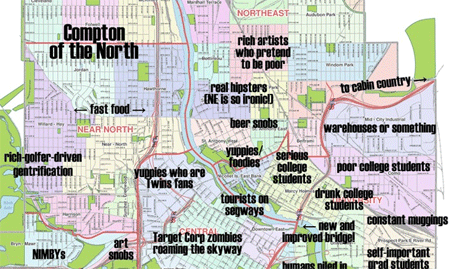 Image from judgementalmaps.com
Image from judgementalmaps.com
You’ve probably seen this map on at least one of your social media feeds since it was posted last week. The map stereotyping neighborhoods in Minneapolis was inspired by the work of Trent Gillaspie, a Denver-based comedian.
He told the Strib in a story published today:
“I moved around a lot, and when people asked where I lived, I was able to tell the name of the neighborhood or what kind of neighborhood it was,” he said. “But then I got to saying, ‘We live in taco cart headquarters,’ and people would say, ‘Oh, yeah, I know exactly where that is.’ It was not something racial or cultural, more of an identifier. It was meant to be lighthearted, satirical, joking. So if you make fun of everyone, you don’t get any flak.”
The Minneapolis map, made by a local woman, certainly got flak. She removed her name from it after negative comments like this one:
“I understand that this is an attempt at satire, but it’s still satire from a place of privilege, that’s my point. People of color aren’t given the privilege to define their own communities in a positive, or even complex manner, to the outside world, while white people are able to define not only their own communities, but also other people’s. That’s exactly what the creator of this map is doing, all intentions aside.”
Race dominated most of the discussion, not surprisingly. But the usefulness of stereotypes in general deserves some thought, I think. Stereotypes are quick generalizations that contain some truth, but leave out details and nuance.
Do you want to know what it’s really like somewhere else? Go there. Talk to people who live there. Heck, move there. I understand that what’s different is what’s interesting. It’s when differences are all that is discussed that I get worried.
“The important thing is that we need to understand there are stereotypes that exist,” Gillaspie told the StarTribune.
While this is true, I don’t see how repeating stereotypes helps us understand, or learn, anything.
